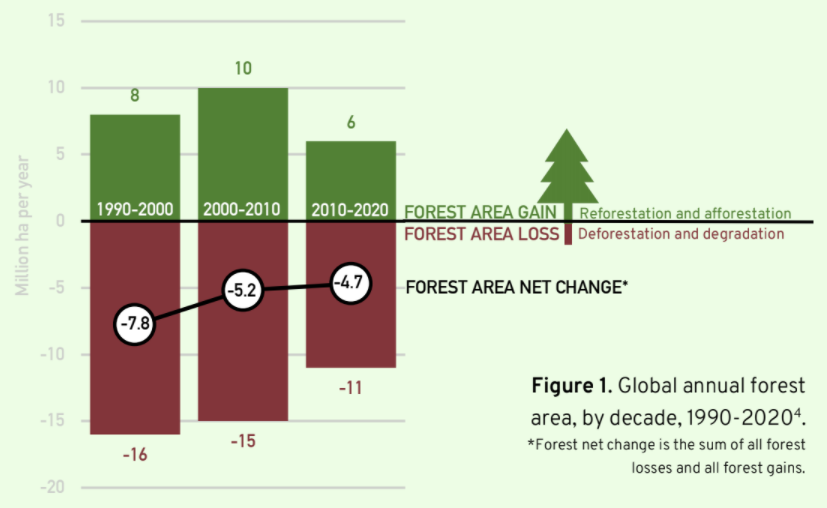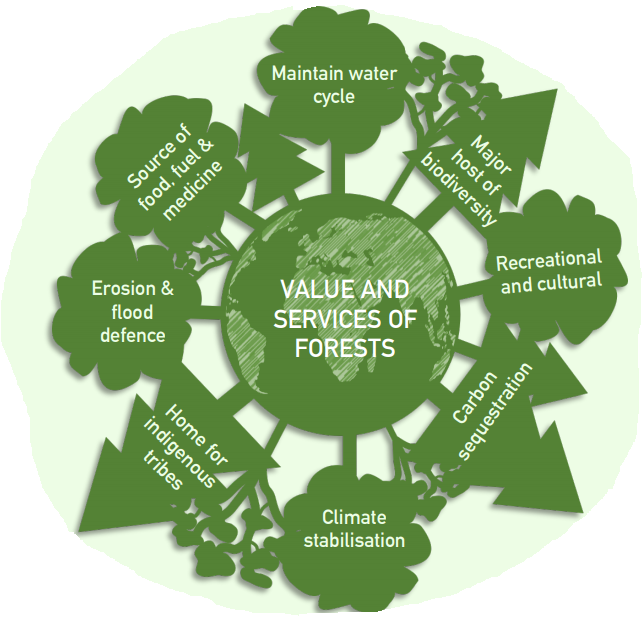Jess Roberts
What is Deforestation?
Deforestation is typically referred to as the conversion of forest into an alternate land use through the permanent reduction of tree canopy cover below 10%. This is a process which can take place suddenly through mass destruction events such as wildfires, or gradually over time as a result of progressive degradation. Deforestation has always occurred naturally through phenomenon such as wind-fell events but has vastly increased over the last few decades due to anthropogenic forcing. Since humans began cutting down trees, approximately 46% of them have been felled. For perspective, since 1990 we have lost around 178million hectares (Ha) of forest – an area approximately the size of Libya.
The world’s forest area is still decreasing overall, but the rate of decrease has slowed over recent decades. This is due to lower rates of deforestation in conjunction with continued forest expansion in the form of natural regeneration and planted forest. Forest expansion is predominantly the result of reforestation and afforestation efforts. Naturally regenerating forest still comprises 93% of all forests, while planted and plantation forests comprise 7% total.
Approximately 726 million Ha of forests are protected worldwide – having increased by 191 million Ha since 1990, although this increase has slowed 2010-2020. The distribution of protection status is different across regions, with South America having the highest share of protected forest at 31%, compared with Europe at 6%.
What are the drivers of deforestation?
A driver of deforestation – also referred to as a cause – is a description of the dominant activity which results in the loss of tree stock and canopy cover. There is no global standard of deforestation drivers defined, but there is consensus in the literature that agricultural expansion, infrastructure development, mining, oil and charcoal production as well as wildfires pose the largest threats to forests. These are known as ‘direct’ drivers, although ‘indirect’ drivers are also crucial to consider. Indirect drivers are localised factors which affect the direct drivers, such as governance, corruption, culture and population density.
The top 4 drivers of deforestation identified by Curtis, et al (2018) contribute to approximately a quarter of global forest loss each, but their relative and total contribution varies greatly per region.
Permanent land-use change from forestry to agriculture has been identified as the most severe threat to tropical forested landscapes with varying contributions from different commodity markets and different actors. For example, rice is a top commercial and subsistence crop in Asian and African landscapes and reported to exceed all other crops as a main driver. In American landscapes, agriculture is characterised by small- to medium-holdings while medium- to large-scale commercial holdings of large agribusinesses are more common in Asia and South America.
Other export crops destined for international markets such as rubber, soy, oil palm, cocoa and coffee are also driving tropical forest conversion.
What are the effects of deforestation?
In order to understand the implications of deforestation, it is critical to first understand the value and services of forests. Global forests provide local and global climate regulation, defence against extreme weather events, are home to the majority of the world’s biodiversity and some indigenous tribes, carbon sequestration, recreational and cultural value as well as food, fuel and medicine for humans. By continuing to destroy forests, mankind risks the loss of these services and value.
Environmental degradation and loss of natural forest systems in the form of deforestation has short- and long-term impacts which arise in the absence of the services that forests provide. The foremost effects of forest removal manifest at a local level, where the removal of the flood and filtration barrier increases the vulnerability of the adjacent populations and infrastructure to extreme weather events – exacerbated through reduced availability of resources such as food, fuel and medicine from the forest. The removal of forests from soil also causes it to de-stabilize and it is more readily eroded and washed away – often leading to declines in crop and fishery yields, disruption of hydroelectric projects and irrigation infrastructure as well as increased flood risk from siltation.
Diminished forest cover also means reduced evapotranspiration which normally contributes to the local formation of rainclouds. Fewer rainclouds as a result can push areas into drought, leading to water scarcity for the human populations and loss of crop productivity. There are some concerns that a significant decline in rainfall as a result of deforestation would trigger a positive-feedback mechanism whereby surrounding forest areas are desiccated, rendering them more vulnerable to wildfires. Furthermore, forest removal is the direct removal of habitats –causing species loss and extinction.
“Forests play the critical role of locking up atmospheric carbon through photosynthesis”
Forests play the critical role of locking up atmospheric carbon through photosynthesis. When forests are burned, degraded, or removed, the inverse process occurs – large amounts of carbon dioxide are released into the atmosphere. The destruction of forests and peatlands releases more than a billion metric tons of carbon into the atmosphere each year. Deforestation accelerates the on-going effects of climate change through both the reduced removal of carbon dioxide from the atmosphere due to fewer trees, and the contribution of carbon dioxide to the atmosphere from the cleared and burned trees themselves.



